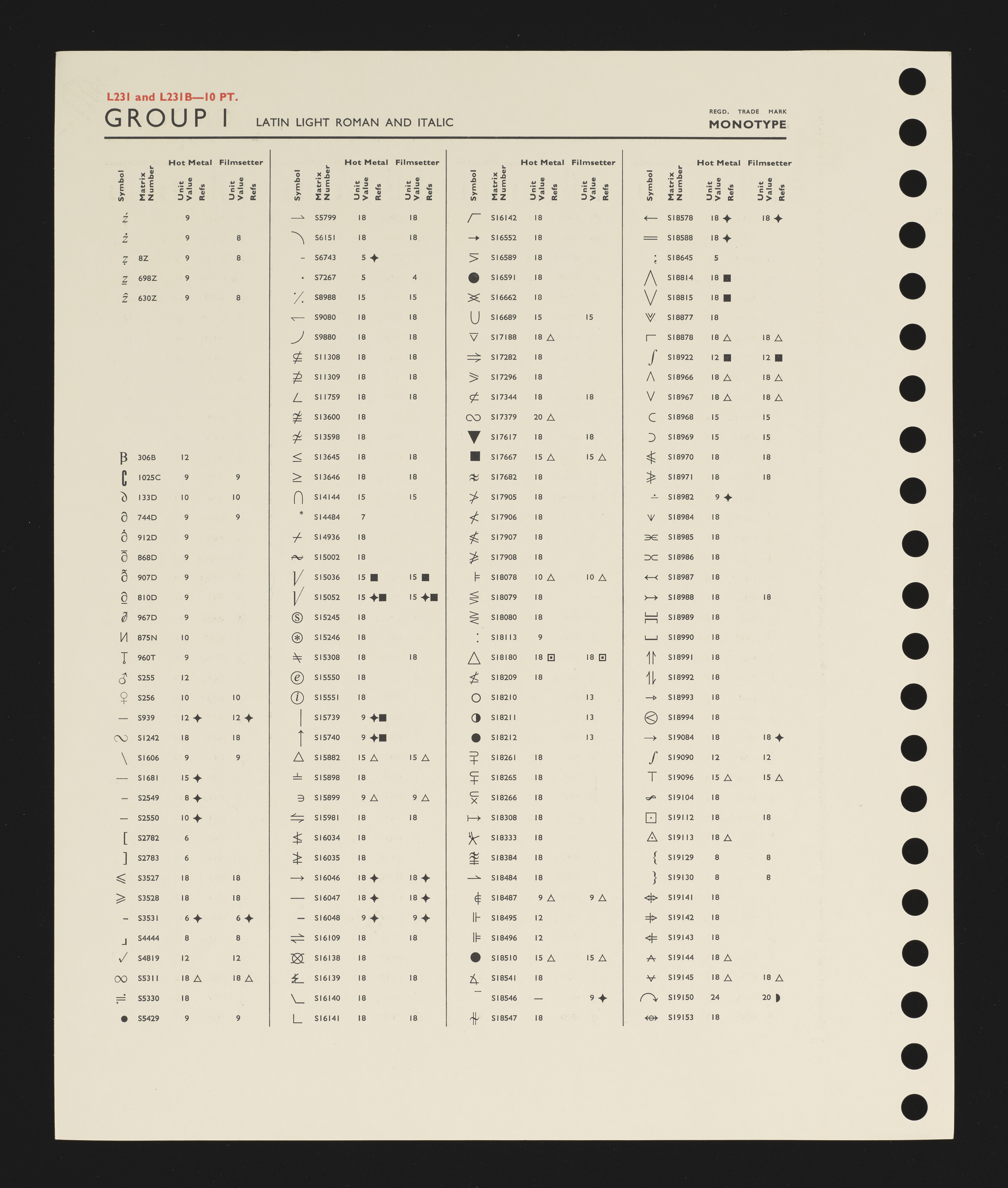
Part 1: U+237C ⍼ RIGHT ANGLE WITH DOWNWARDS ZIGZAG ARROW
This is part 2.
Part 3: Monotype Mathematical Sorts
Part 4: U+237C ⍼ is (also) S9576 ⍼
Many thanks to Barbara Beeton, James David Mason, Anders Berglund, David Bolton, Andy Whyte,
Claire Welford-Elkin, and Bob Richardson.
Where were we?
I’ve summarized a chronological timeline in the previous post, but here are the highlights in reverse chronological, corresponding roughly to the order in which I’ve discovered the information:
- ISO/IEC JTC1/SC2/WG2 N2191 (Proposal for Encoding Additional Mathematical Symbols) adds U+237C ⍼ to the Unicode standard, which took characters from
- The STIX project, whose character tables were compiled by Barbara Beeton, taking characters from, among many other sources,
- ISO/IEC TR 9573-13 (Public entity sets for mathematics and science), a technical report for SGML, where the trail ends.
Further investigation into various glyph registries and entity tables yielded no additional information.
About a year later, I went over everything I knew again and started looking for new leads. The rest of this post collects together the live Twitter updates I had been posting during this process.
Who wrote TR 9573-13?
The ISO standards site tells us that TR 9573-13 was the responsibility of subcommittee 34 (SC 34) under Joint Technical Committee 1 (JTC 1) of ISO/IEC. A fortuitous search led to a historical account of JTC 1/SC34, originally compiled by James David Mason, who was vice-chairman of SC 34. Given the age of the document, I doubted the email address listed for him was up to date, but eventually I found him on Linkedin, which indicated that he’s a co-chair for the Balisage Conference. I contacted the conference chair, who put me in contact with Mason.
From the historical account and Mason himself, I’ve found that working group 1 (WG 1) of SC 34 was responsible for ISO 8879, the SGML standard, as well as TR 9573-13. The main people working on these were Charles Goldfarb, the inventor of SGML, and Anders Berglund, who was responsible for TR 9573-13. The entire SC 34 committee records are now at the Charles Babbage Institute Archives at the University of Minnesota, and consists of 9.5 cubic feet of material in 10 boxes (!). Luckily, I wouldn’t have to fly to Minneapolis to sift through all of these records, because eventually Mason managed to find me a current email address for Berglund.
Where is TR 9573-13 from?
Berglund tells me that the entity sets for TR 9573-13 come from three sources:
- ISO/IEC 8859, a precursor of ISO/IEC 10646 and Unicode;
- MathSci, an expansion of mathfile, Appendix D from the AMS; and
- various typeface catalogues, notably Monotype.
Our glyph comes from Monotype under the matrix serial number S16139.

Unfortunately (but reasonably, as all of this is from three decades ago), Berglund doesn’t have any notes on which Monotype catalogues were referenced. However, I’ve separately confirmed that the symbol is indeed from Monotype from their archives. Although the Type Archive, which held the Monotype Collection, is now shutting down, the Science Museum Group has taken photographs of the collection. There are over 5000 punches and matrices in the collection, but I was extremely lucky with my search keywords and happened upon a set of punches, Extraneous sorts (L231)…
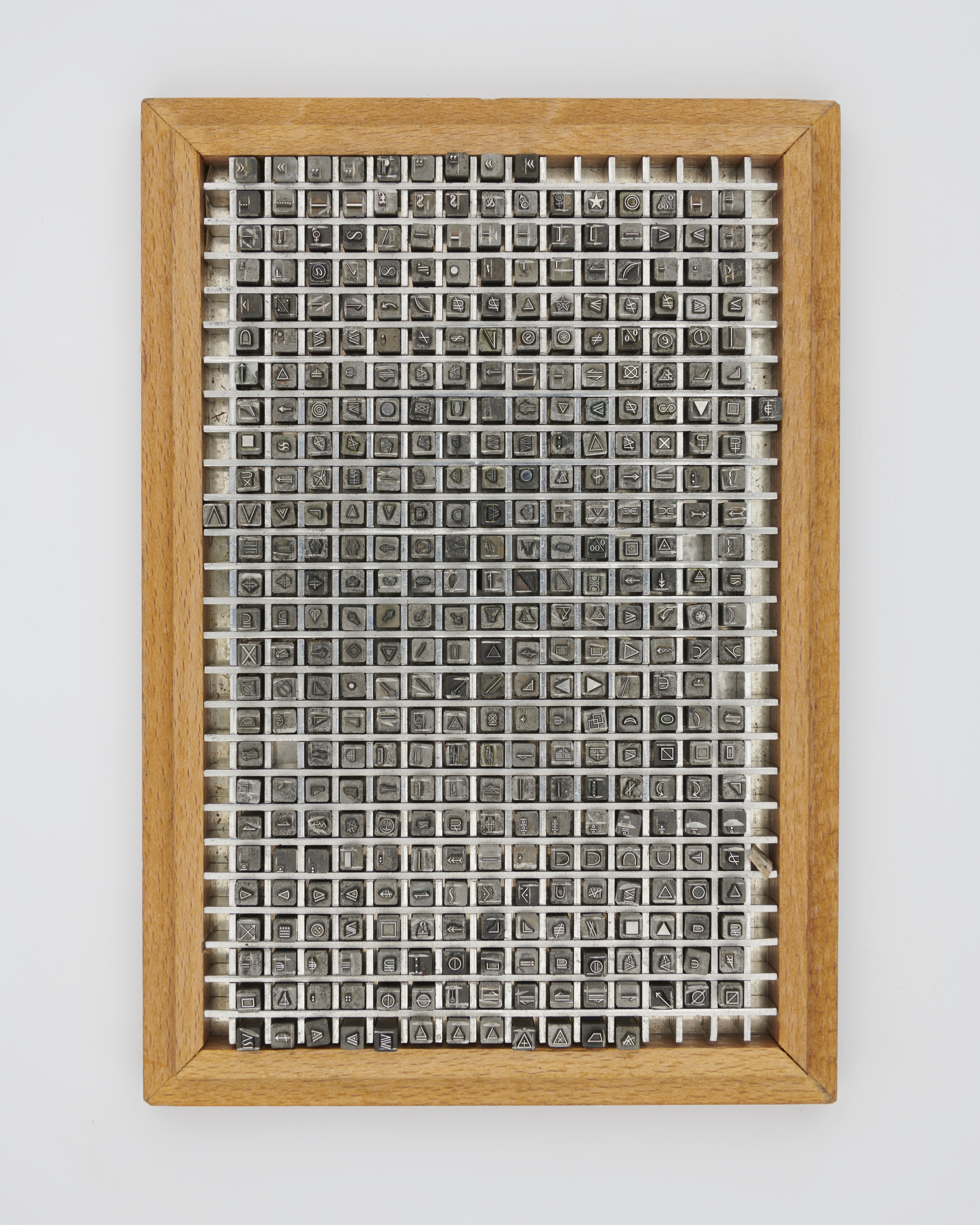
… which contains that very sort.
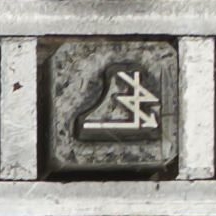
Which Monotype catalogue is it in?
The SMG holds one catalogue, the Specimen Book of ‘Monotype’ Printing Type. Its index does list L231 as an “Extraneous sorts” series, but those specimen sheets aren’t included in this book.
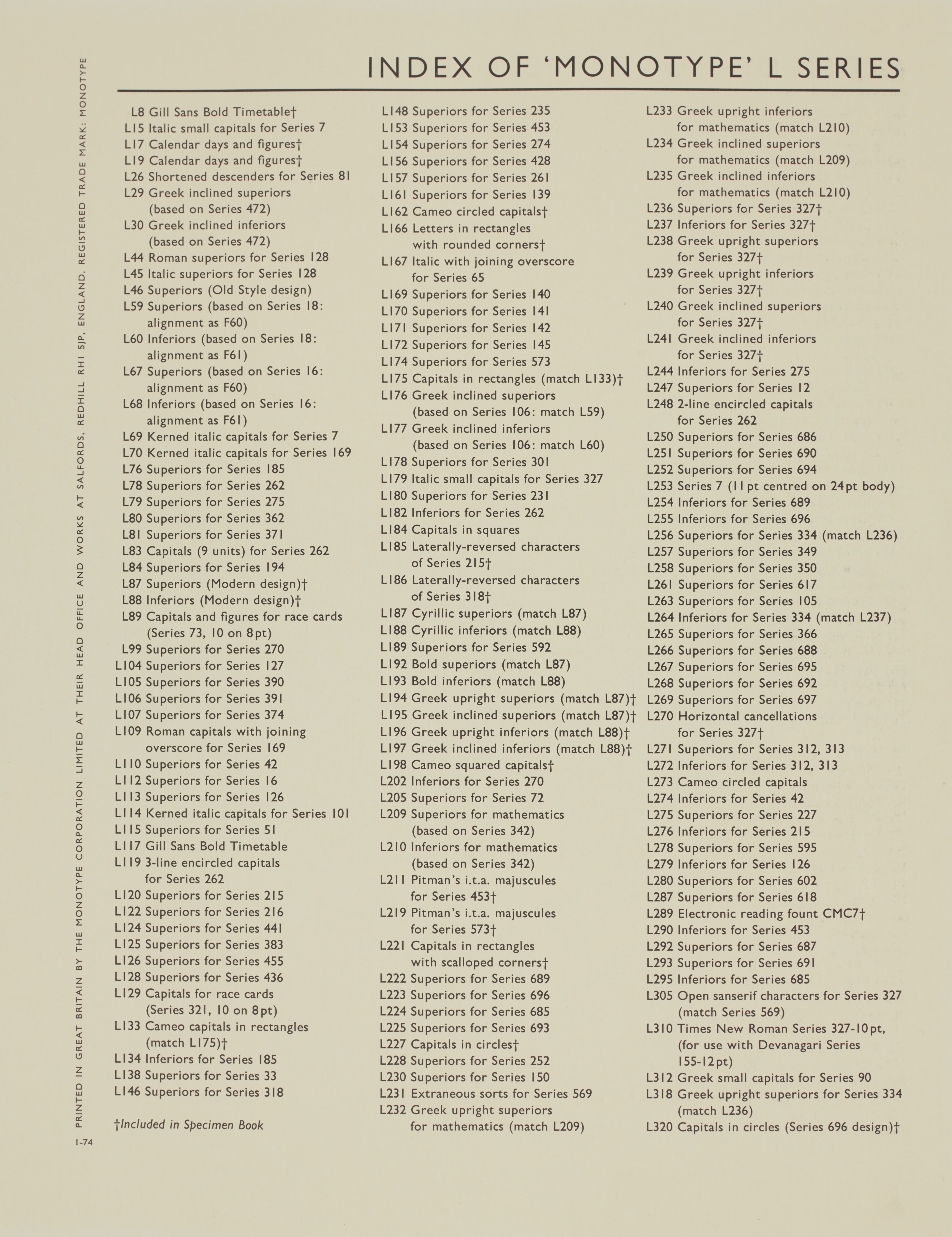
While looking for other catalogues that Monotype have published, I came across Alembic Press’ collection of Monotype publications. I contacted David Bolton at the press for help with the catalogues, who got back to me with a list of publications of lists of signs that do not contain S16139. Since the serial number begins with S, it should be listed as a mathematical special sign, but it was not found in any of:
- Monotype Special Sorts (1931, 1947) — up to S1153, S6844;
- Monotype Special Signs (1954 – 1963) — up to S11819;
- Monotype Mathematical Sorts List (1956) — up to S10477;
- 4-Line Mathematics Classified List of Characters (1967, 1970) — up to S19717, S20620.
Although the serial numbers in 4-Line Mathematics do go past S16139, it excludes several ranges such as S16137 – S16237 and S18325 – S18347, likely characters not involved in 4-line mathematical typesetting or were specialized commissioned characters.
Many signs were for individual customers, so might not merit being published in a list, although for example I happen to have signs S2120 to S2125, which were only for Jesus College Cambridge Boat Club as far as I know, but which do feature in the 1947 list.
Alembic Press lists, but does not possess, one final document, List of Mathematical Characters. However, it can be found in the Morison Collection at the Cambridge University Library. According to their catalogue, they have three documents under this name:
- [1970.11.585] List of mathematical characters. London, 1970. 72p; ring bdg. [For Monotype and Monophoto.]
- [1972.12.177] List of mathematical characters. np, 1972. 21 loose sheets. [Sheets for insertion in List (1970).]
- [Morison.MC.D25] List of mathematical characters. [London], nd. ca50 leaves
I contacted the Rare Books department, whose superintendent Claire Welford-Elkin sent me photographs of two documents with this name. The first, under Morison.MC.D25, is List of mathematical characters: ‘Monotype’ 4-line Mathematics Series 569 & L231, ‘Monophoto’ Times Mathematics Series 569B & L231B. The second, under 1972.12.177, is L231 and L231B (July 1972), a set of 21 sheets meant to be inserted at the end of the List. Since S16139 was found in the set of punches of Extraneous Sorts in series L231, I believe it may appear within these 21 sheets.
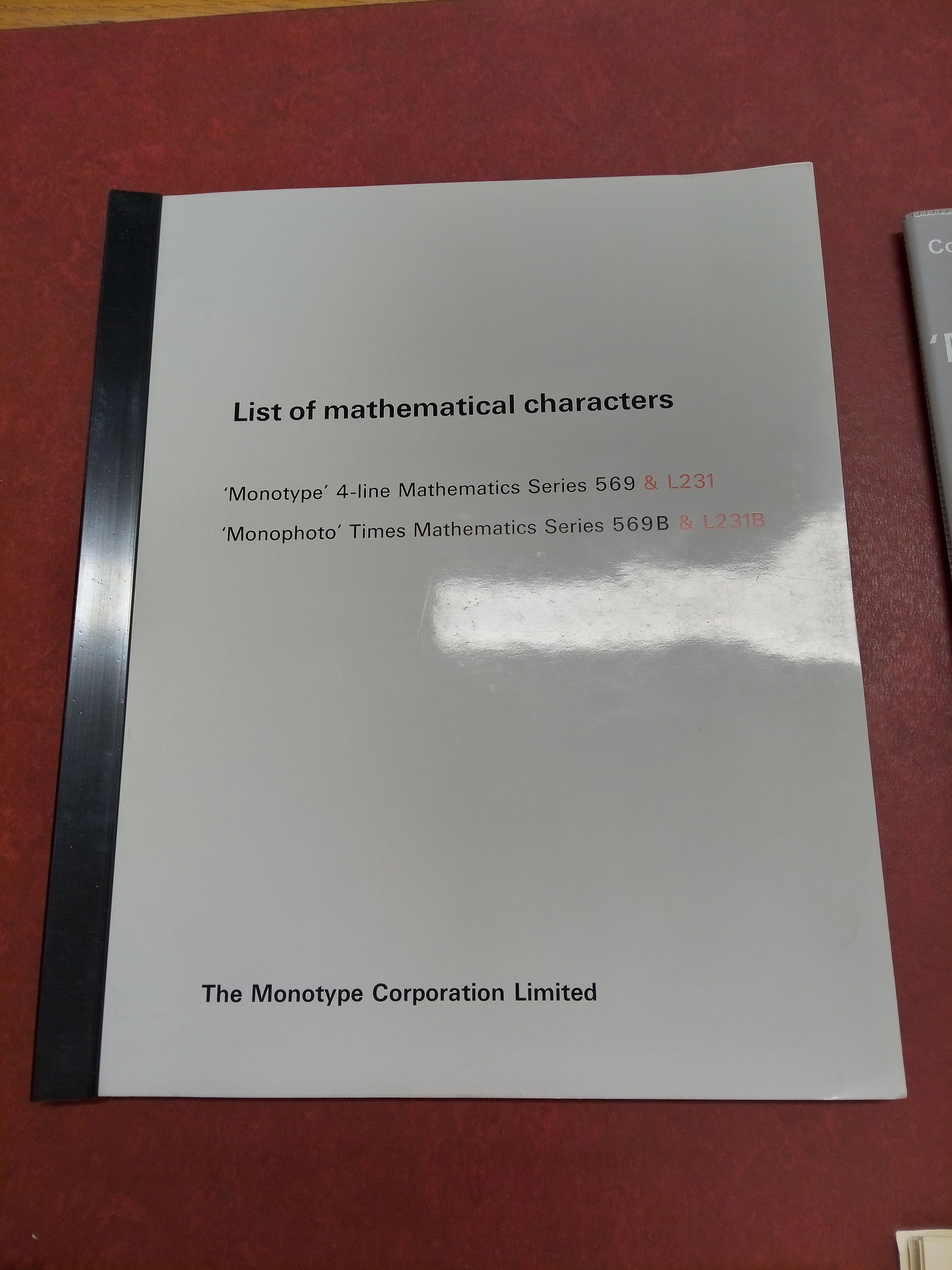
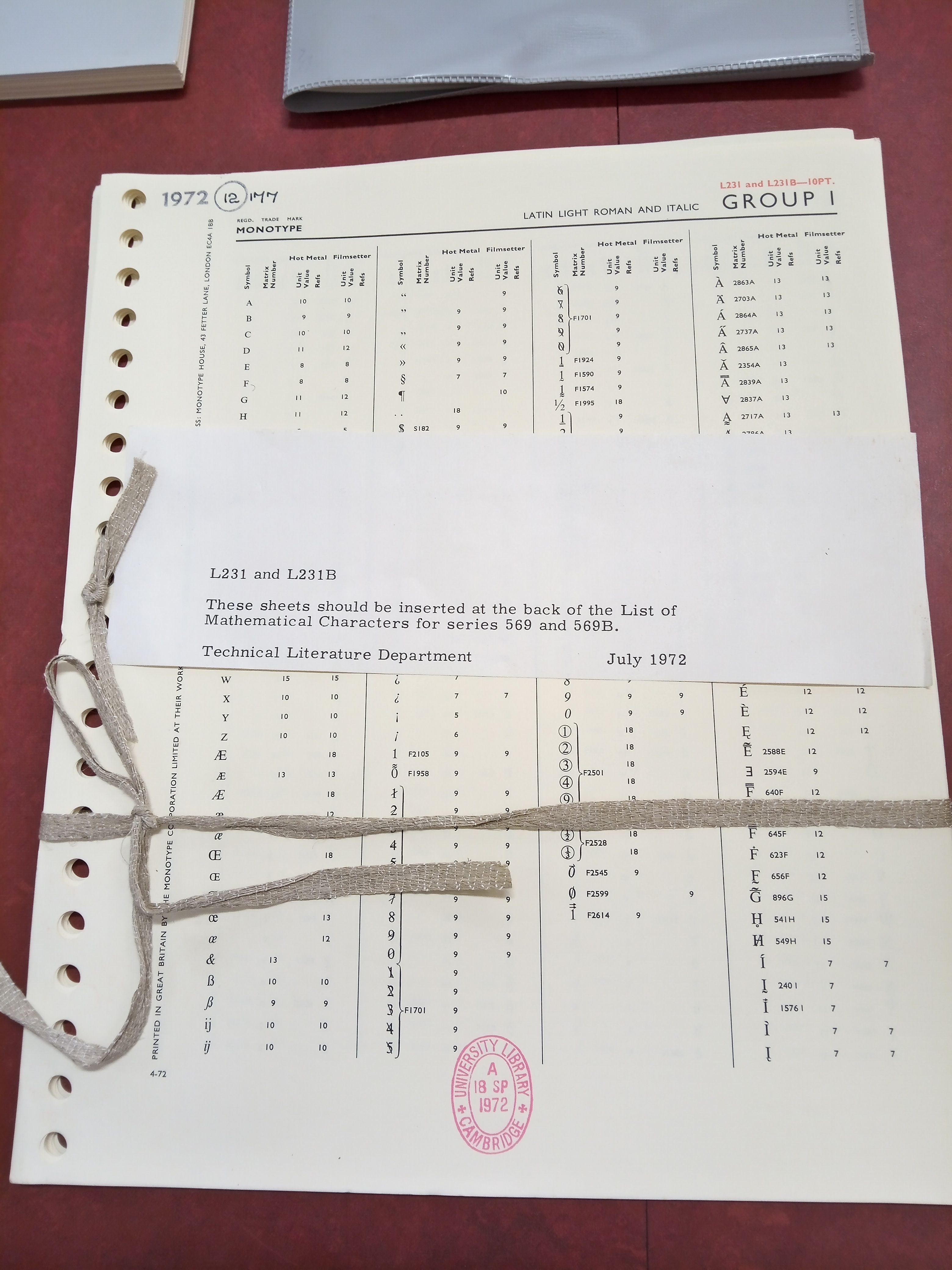
update: Back from the Morison Collection
After this story received some attention from HackerNews (again), Cambridge alumnus Andy Whyte contacted me and offered to go visit and take photographs of the items in person, and determined that S16139 is indeed in 1972.12.177 on the sixth sheet. I requested a digital scan of that page, which cost 18£.
There it is, on the third-to-last row of the second column: S16139. Given its similarity to the photo that Berglund sent me, I think this is the very document from his notes.
Where else?
St Bride Library is a library dedicated to the history of print, typography, and design, and they hold a number of Monotype documents. I’ve contacted them about some of these documents, and Bob Richardson got back to me with some information. Here are, I believe, the relevant ones:
- List of mathematical characters, Monotype Corporation Ltd., 1972 — same as the above
- List of Monotype founts and special sorts at the University Press Oxford, Oxford University Press, 1976 — a “slim paperback” that doesn’t contain S16139
- Monotype Special Sorts: Specimens of Arbitrary Characters not included in ordinary sets of Matrices (SB49888), 1932 — according to Bob, “attempts have been made to update some pages by carefully drawing (or printing by hand) examples of newer characters”
As I’m likely physically visiting London next year for other purposes, I might also visit St Bride Library to take a look at these documents, especially the last one. I’m also interested in the whimsically-titled Mathematical sorts in continuous creation: verses written partly in mathematical notation by Arthur H. Phillips from 1957.
I was also informed by Bob Richardson at St Bride about the state of the documents that were formerly at the Type Archive:
All of the Monotype records relating to special characters have now been removed from the Type Archive site at Stockwell. The documents were palletised for transfer to the National Collections Centre at Wroughton several months ago and are completely inaccessible. The pallets will be stored in climate controlled conditions at their new home but I cannot imagine that it would be easy to gain access since this would involve a fork-lift truck and considerable manpower.
The Type Archive did hold some paper records for the kind of character you describe, but they were of a technical nature and would not have provided much more than a reference number, a date of creation and details of the point sizes and faces in which the character was available. I cannot recall seeing any details of a specific customer for any special characters, other than in the Typographical Committee records.
It appears there’s only a single surviving volume of the Typographical Committee Minutes from 1959 to 1964, which only contains “typefaces and decorative (border) materials and things like National Emblems”. I think these committee records would’ve been my best bet at uncovering the history of the mathematical sorts — if they had still existed.




